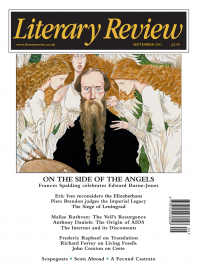Patricia Duncker
Miracles of Life
The Translation of the Bones
By Francesca Kay
Weidenfeld & Nicolson 213pp £12.99
‘Now faith is the substance of things hoped for, the evidence of things not seen.’ This verse from St Paul’s Letter to the Hebrews serves as the epigraph for Francesca Kay’s second novel. The story, set in a contemporary south London Catholic community, takes shape around a miracle. I can imagine the tabloid headlines: FAT DOTTY SPINSTER SEES JESUS STATUE WINK AND BLEED. Unfortunately, a nurse at the hospital believes the enormous, mentally subnormal woman and behold, the press appear and the church is invaded.
The Catholic Church hasn’t enjoyed a good press in recent years. The interminable child-abuse scandals revealed a rotten institution, and Pope Benedict rattles the Muslim cages from time to time with medieval quotations. How, one wonders, will Kay deal with the subject? The book’s structure, rooted in domestic concerns, moves from one member of the church to another, creating a slice-of-life fiction. Father Diamond nurses his doubts, while his senior colleague, Father O’Connor, is on sabbatical. The lovely Stella Morrison, married to a Tory MP (Central Dorset has probably been Tory since the Middle Ages), desperately misses her young son Felix, incarcerated in a boarding school. Mrs Armitage is anxious for her son, serving in Afghanistan. Will he return home alive? Fidelma O’Reilly, mired in her enormous bulk, slumps in a tower block, housebound on the nineteenth floor. Her adult daughter, Mary-Margaret, covers the statue of the crucified Jesus in precious ointment, ready for Easter, and it is she who witnesses the miracle.
This cross section of the Catholic community carefully mirrors the British class hierarchy. Here, the politics of the novel become distinctly sinister. All these women are mothers. Mrs Armitage and Stella Morrison adore their sons to the point of obsession. Fidelma is an unloving mother. Her lack of love sends her simple-minded daughter off cruising for priests, adoring statues, and inveigling the overburdened neighbour’s children, especially the youngest son Shamso, into their flat to eat crisps and chocolate fingers. Mrs Abdi, another mother doing her best and failing, represents poor immigrants with dozens of offspring. So far, so politically correct. Myths of maternal love and the absence thereof rebound through this novel. And the central question is biblical. Would you be prepared to sacrifice your son if God commanded you to?
The sources of trouble, Mary-Margaret and Fidelma, are obese benefit claimants who don’t work. Fidelma savagely enjoys the irony of the words: disability benefits. Do they benefit a society that locks these monstrous female hulks in tower blocks? Neither character can escape authorial commentary on her grotesque mass of fat. The result is disturbing. Loving mothers are haloed saints, and fat, unmarried, uneducated women are religious psychotics. Kay’s floating verbless sentences are cloying rather than poetic, and the accumulated similes – ‘white as bone, as moonlight, white as broken shell’ – suggest that more ruthless editing would have been useful.
Yet the pattern generated by the fiction is unfailingly gripping, filled with the essential ingredients – tension and emotion. The Christian structure of sacrifice and redemption is echoed through the plot. The church, fittingly, becomes a crime scene. There is a long separation between the sacrificial climax, which I cannot describe without giving away an unexpected twist in the plot, and the ending of the book, which leaves space for analysis of the consequences, suitable waves of guilt in the main characters, and some tight-lipped recriminations. The novel finally argues a strong moral case. We are all part of one another; each action ripples outwards, with unexpected effects. And love is due to those who are entirely unlovable. Who emerges on the moral high ground? Amazingly, the priests. Father O’Connor appears like the cavalry, strong in faith, and Father Diamond, the most interesting character despite his clichéd doubts, hears the unbearable roar on the other side of silence but still manages to gather up his appalling parishioners, who have fallen by the wayside or among thorns, and do the right thing.

Sign Up to our newsletter
Receive free articles, highlights from the archive, news, details of prizes, and much more.@Lit_Review
Follow Literary Review on Twitter
Twitter Feed
It wasn’t until 1825 that Pepys’s diary became available for the first time. How it was eventually decrypted and published is a story of subterfuge and duplicity.
Kate Loveman tells the tale.
Kate Loveman - Publishing Pepys
Kate Loveman: Publishing Pepys
literaryreview.co.uk
Arthur Christopher Benson was a pillar of the Edwardian establishment. He was supremely well connected. As his newly published diaries reveal, he was also riotously indiscreet.
Piers Brendon compares Benson’s journals to others from the 20th century.
Piers Brendon - Land of Dopes & Tories
Piers Brendon: Land of Dopes & Tories - The Benson Diaries: Selections from the Diary of Arthur Christopher Benson by Eamon Duffy & Ronald Hyam (edd)
literaryreview.co.uk
Of the siblings Gwen and Augustus John, it is Augustus who has commanded most attention from collectors and connoisseurs.
Was he really the finer artist, asks Tanya Harrod, or is it time Gwen emerged from her brother’s shadow?
Tanya Harrod - Cut from the Same Canvas
Tanya Harrod: Cut from the Same Canvas - Artists, Siblings, Visionaries: The Lives and Loves of Gwen and Augustus John by Judith Mackrell
literaryreview.co.uk